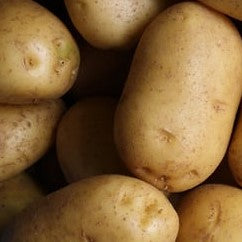Available in store March - June
Potatoes are a high yielding, easy to grow crop for the home gardener. It is also a fun crop for children to grow. They are easy to plant, and it is like a little treasure hunt when it comes time for harvesting. Potatoes can be grown in deep containers or in rows in your vegetable garden.
Varieties
There are many different varieties of potatoes that grow well in our area. They can be divided into waxy varieties, starchy varieties, and ones that are in between. Pontiac and Norland are two popular red skinned potatoes in the waxy category and are great for roasting and frying up in butter. Yum! Russet and Kennebec are more starchy potato varieties that are excellent for mashing or baking. Yukon Gold is an in-between variety that is becoming very popular in our area. It can be used for almost any purpose. If you are looking for some fun and colorful varieties try Huckleberry Gold, Purple Viking, French Fingerling, or Russian Banana.
Planting
Most gardeners in Cache Valley will begin to plant their potatoes around Easter Day. If you are worried about frost damage you should plant closer to Mother’s Day. Choose a very sunny location with loose, fluffy soil. If you have heavy clay soil, amend your plot with soil building compost straw and/or Zeolite before planting. If you skip this step your potatoes will be small and undeveloped. The next step is to buy only seed potatoes. Do not use potatoes that you buy in the grocery store. These are typically treated with an anti-sprouting agent. Cut your seed potatoes into chunks that have 2-3 eyes each (small tubers can be left whole). For best results let the cut pieces of potato dry at least overnight, up to a full day or more. This will help avoid some diseases. Once the seed potatoes are dried, place each chunk 4” deep and space 1-1 ½’ apart. To increase your yield, add a tablespoon of Bone Meal or Happy Frog Tomato & Vegetable Food to each hole, mix in lightly, then place the potato on top. Water with Kangaroots and Fungicide 5 before covering with soil. This will slowly feed your plant for the entire season. Once the tops emerge, begin mounding the surrounding soil up over the plant always leaving the top couple of inches above the soil. You want to mound the soil a total of 4-6” above the original soil level. This should be done in a couple of installments. Plants should be kept evenly moist throughout the entire growing season. Do not over water as this will lead to root rot and a poor harvest. Stop watering once the tops begin to go yellow or brown.
Harvesting and Storage
Once the plants bloom, you should be able to gently brush back the soil and begin harvesting baby potatoes. If you plan on storing your potatoes, you can wait until the tops die back and simply dig up the entire plant. Do this carefully to avoid cutting or damaging the tubers. Let the tubers dry for a few hours in the field to make dirt removal easier. Sort your potatoes, discarding (or using!) any bruised or cut tubers. Store in burlap sacks in a cool (40° F), dark and dry location.

